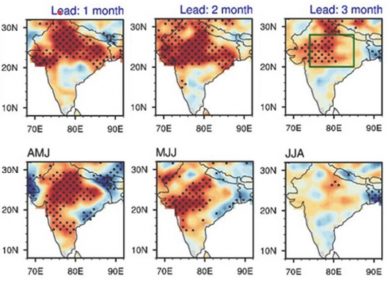Divining Monsoon Rainfall Months in Advance with Satellites and Simulations
July 16, 2020

Researchers affiliated with The University of Texas at Austin have developed a strategy that more accurately predicts seasonal rainfall over the Asian monsoon region and could provide tangible improvements to water resource management on the Indian subcontinent, impacting more than one fifth of the world’s population.
Using satellite data on the size and extent of the snow pack on the Tibetan plateau and in Siberia, the team created better climate model simulations that predict variation in monsoon rainfall the following season. The new research was published online in Environmental Research Letters.
“We are focusing on the time scale beyond the 14 days of weather forecasting to a farther, seasonal outlook,” said Peirong Lin, currently a postdoc at Princeton University who helped lead this research project while a graduate student at UT Jackson School of Geosciences. “This is a very important time scale because water resource managers need to know the forecast months prior to the monsoon onset for decisions about resources and agriculture.”
Monsoon winds and the rain that comes with them are propelled by the temperature difference between land and ocean. Current climate forecasting relies on computer models that use general circulation models, soil moisture and other factors. The new model uses complementary satellite data to improve these forecasts by revisiting a historically recognized link between snow pack characteristics and monsoon strength over the Asian monsoon region, especially on the Indian subcontinent.
“For Indian monsoons, it was empirically known almost 140 years ago that rainfall in the summer was connected to snowpack in the Himalaya,” said Zong-Liang Yang, professor in the Jackson School’s Department of Geological Sciences. “But with our new model, we now have a deeper understanding of the interconnected processes, and we are able to quantify such connection that predicts monsoon season strength from snow pack.”
The new research uses both the breadth and depth of winter snows to more accurately simulate monsoons. The information constraining the new models comes from two satellites: the Moderate Resolution Imaging Spectroradiometer (MODIS) that provides data about snow cover, and the Gravity Recovery and Climate Experiment (GRACE) with gravitational information that determines the depth of snow. Combined, the observations make the modeled snow conditions more realistic and demonstrate that heavy snow pack—with slower heating of landmass in comparison to the ocean—leads to weaker monsoons. Conversely, milder winter snows lead to stronger monsoons.
The research also finds that snow in Tibet and Siberia have different roles in moderating monsoon rainfall. The snow on the Tibetan plateau is relatively thin compared to Siberia’s. Detailed analysis in the research paper shows that the Tibetan snow pack improves a few weeks of forecasting. It is the Siberian snow that melts later in the summer, thereby having a longer impact on the climate system, that influences predictions with greater lead time and further into peak monsoon season.
There are caveats to this research. Monsoons impact a far wider region of the world, but the team’s simulations showed the most pronounced forecasts were obtained only in the Indian subcontinent, and they were not as effective over East Asia.

“The forecast is mostly improved over the Indian subcontinent likely because Indian monsoon is more sensitive to snow changes on land,” said Lin. “The East Asian monsoon may be more complex.”
Still, the team hopes that the new strategy developed by their research will be used to improve seasonal forecasts beyond the Indian subcontinent, with future research that expands the current simulations.
“The work that we accomplished at the Jackson School is leading the field, but it will take time before these ideas are implemented in operational modeling systems in operational centers,” said Yang. “But our goal is to decrease the research-to-operation gap and find ways to use many of the underutilized satellites that can inform long-term weather prediction.”
Additional authors of this research include Jiangfeng Wei, currently affiliated with Nanjing University of Information Science and Technology in China; Robert E Dickinson of the Jackson School of Geosciences; Yongfei Zhang, currently affiliated with Program in Atmospheric and Oceanic Sciences at Princeton University; and Long Zhao, currently affiliated with Southwest University in Chongqing, China. All research by all authors was done while affiliated with the Jackson School of Geosciences.
For more information, contact: Anton Caputo, Jackson School of Geosciences, 512-232-9623; Monica Kortsha, Jackson School of Geosciences, 512-471-2241.
